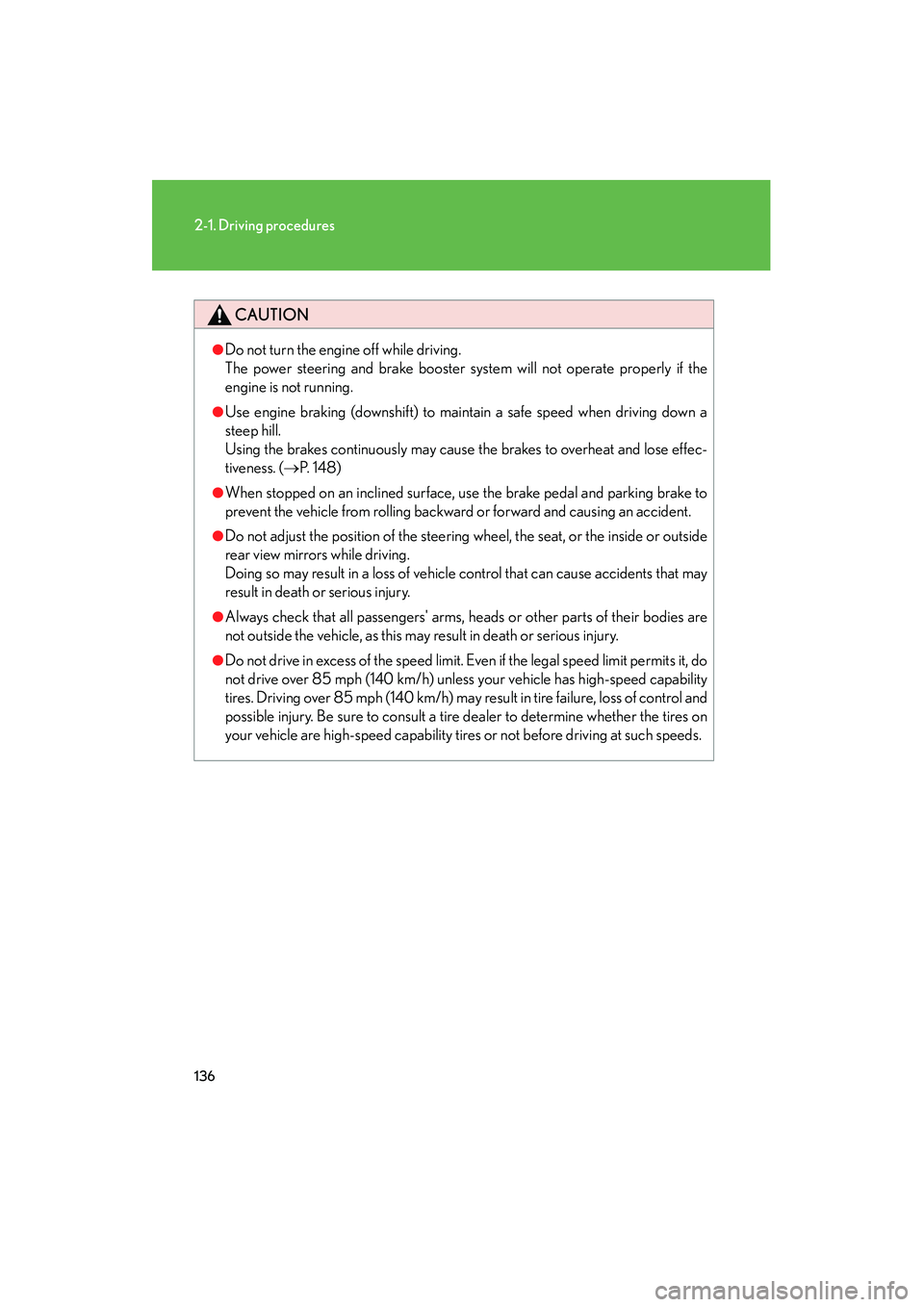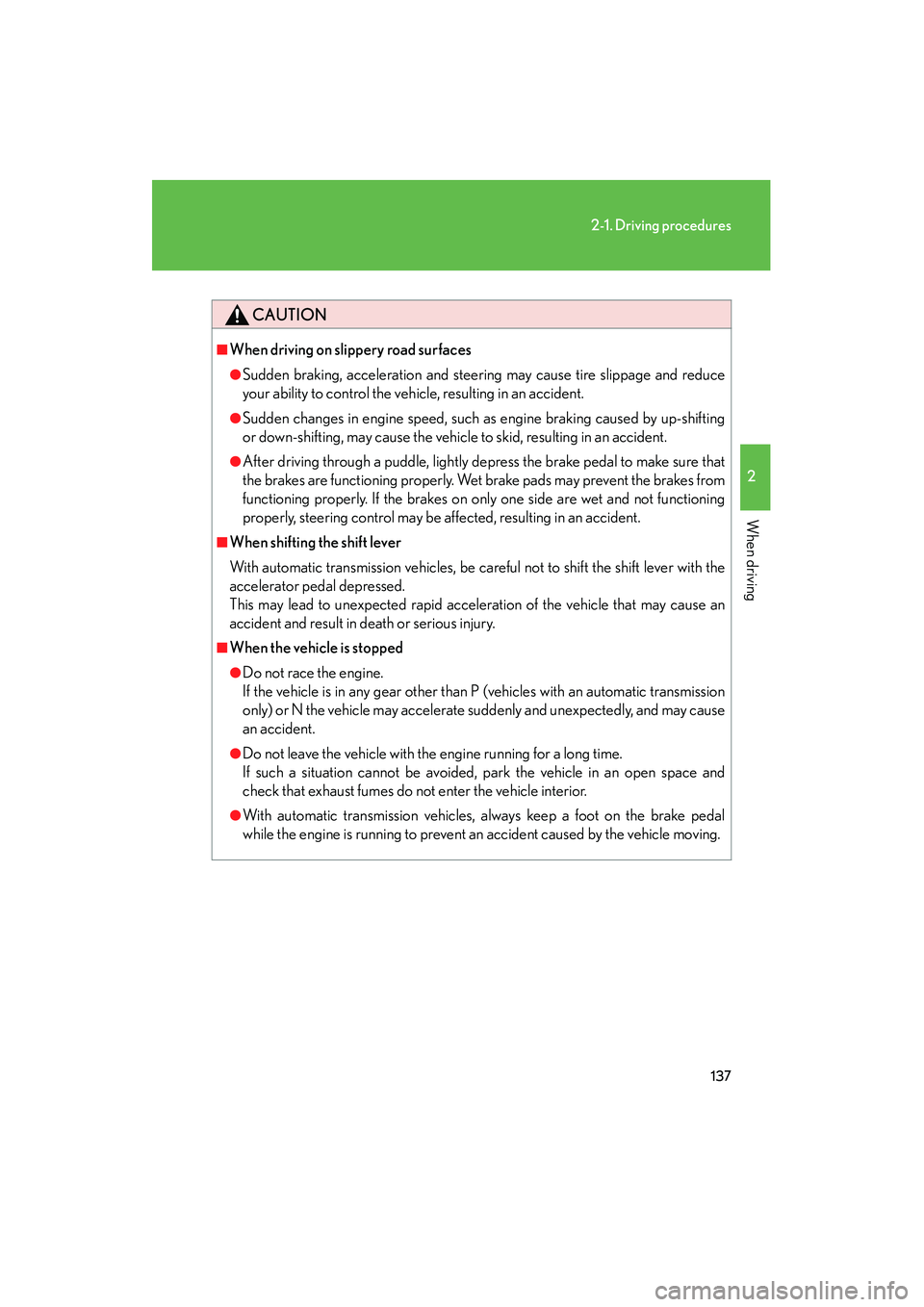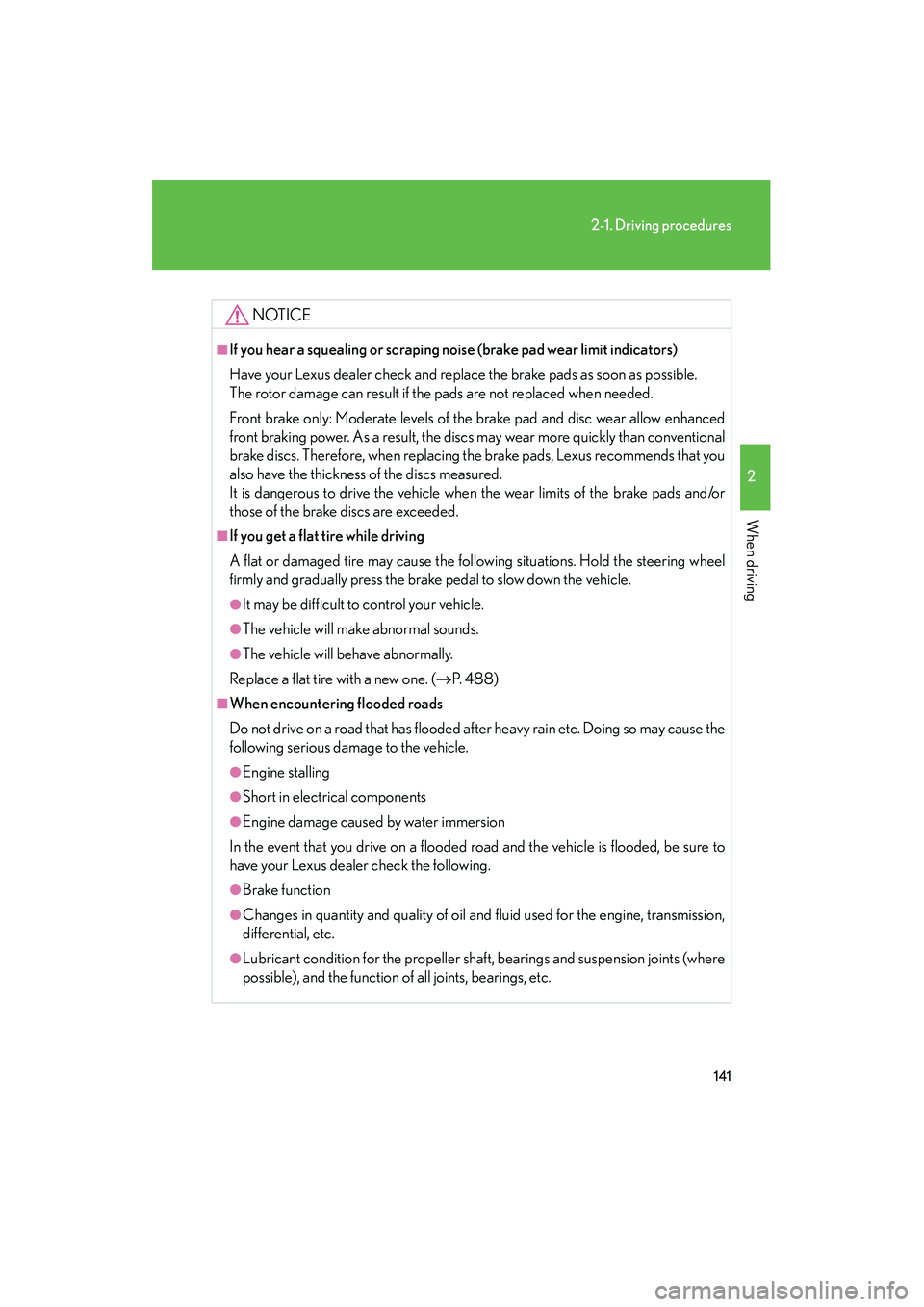steering Lexus IS250C 2010 Service Manual
[x] Cancel search | Manufacturer: LEXUS, Model Year: 2010, Model line: IS250C, Model: Lexus IS250C 2010Pages: 586, PDF Size: 31.62 MB
Page 137 of 586

136
2-1. Driving procedures
10_IS250C/350C_U
CAUTION
â—ŹDo not turn the engine off while driving.
The power steering and brake booster system will not operate properly if the
engine is not running.
â—ŹUse engine braking (downshift) to maintain a safe speed when driving down a
steep hill.
Using the brakes continuously may cause the brakes to overheat and lose effec-
tiveness. (→P. 1 4 8 )
â—ŹWhen stopped on an inclined surface, use the brake pedal and parking brake to
prevent the vehicle from rolling backward or forward and causing an accident.
â—ŹDo not adjust the position of the steering wheel, the seat, or the inside or outside
rear view mirrors while driving.
Doing so may result in a loss of vehicle control that can cause accidents that may
result in death or serious injury.
â—ŹAlways check that all passengers' arms, heads or other parts of their bodies are
not outside the vehicle, as this may result in death or serious injury.
â—ŹDo not drive in excess of the speed limit. Even if the legal speed limit permits it, do
not drive over 85 mph (140 km/h) unless your vehicle has high-speed capability
tires. Driving over 85 mph (140 km/h) may result in tire failure, loss of control and
possible injury. Be sure to consult a tire dealer to determine whether the tires on
your vehicle are high-speed capability tires or not before driving at such speeds.
Page 138 of 586

137
2-1. Driving procedures
2
When driving
10_IS250C/350C_U
CAUTION
â– When driving on slippery road surfaces
â—ŹSudden braking, acceleration and steering may cause tire slippage and reduce
your ability to control the vehicle, resulting in an accident.
â—ŹSudden changes in engine speed, such as engine braking caused by up-shifting
or down-shifting, may cause the vehicle to skid, resulting in an accident.
â—ŹAfter driving through a puddle, lightly depress the brake pedal to make sure that
the brakes are functioning properly. Wet brake pads may prevent the brakes from
functioning properly. If the brakes on only one side are wet and not functioning
properly, steering control may be affected, resulting in an accident.
â– When shifting the shift lever
With automatic transmission vehicles, be careful not to shift the shift lever with the
accelerator pedal depressed.
This may lead to unexpected rapid acceleration of the vehicle that may cause an
accident and result in death or serious injury.
â– When the vehicle is stopped
â—ŹDo not race the engine.
If the vehicle is in any gear other than P (vehicles with an automatic transmission
only) or N the vehicle may accelerate suddenly and unexpectedly, and may cause
an accident.
â—ŹDo not leave the vehicle with the engine running for a long time.
If such a situation cannot be avoided, park the vehicle in an open space and
check that exhaust fumes do not enter the vehicle interior.
â—ŹWith automatic transmission vehicles, always keep a foot on the brake pedal
while the engine is running to prevent an accident caused by the vehicle moving.
Page 141 of 586

140
2-1. Driving procedures
10_IS250C/350C_U
NOTICE
â– When driving the vehicleWith automatic transmission vehicles
â—ŹDo not use the accelerator pedal or depress the accelerator and brake pedals
together to hold the vehicle on a hill.With manual transmission vehicles
â—ŹDo not rest your foot on the clutch pedal while driving.
Doing so may cause clutch trouble.
â—ŹDo not use any gears other than the first gear when starting off and moving for-
ward.
Doing so may damage the clutch.
â—ŹDo not use the clutch to hold the vehicle when stopping on an uphill grade.
Doing so may damage the clutch.
â– When parking the vehicle
With automatic transmission vehicles, always put the shift lever in P. Failure to do so
may cause the vehicle to move or the vehicle may accelerate suddenly if the accel-
erator pedal is accidentally depressed.
â– Avoiding damage to vehicle parts
â—ŹDo not turn the steering wheel fully in either direction and hold it there for a long
time.
Doing so may damage the power steering motor.
â—ŹWhen driving over bumps in the road, drive as slowly as possible to avoid damag-
ing the wheels, underside of the vehicle, etc.
Page 142 of 586

141
2-1. Driving procedures
2
When driving
10_IS250C/350C_U
NOTICE
â– If you hear a squealing or scraping noise (brake pad wear limit indicators)
Have your Lexus dealer check and replace the brake pads as soon as possible.
The rotor damage can result if the pads are not replaced when needed.
Front brake only: Moderate levels of the brake pad and disc wear allow enhanced
front braking power. As a result, the discs may wear more quickly than conventional
brake discs. Therefore, when replacing the brake pads, Lexus recommends that you
also have the thickness of the discs measured.
It is dangerous to drive the vehicle when the wear limits of the brake pads and/or
those of the brake discs are exceeded.
â– If you get a flat tire while driving
A flat or damaged tire may cause the following situations. Hold the steering wheel
firmly and gradually press the brake pedal to slow down the vehicle.
â—ŹIt may be difficult to control your vehicle.
â—ŹThe vehicle will make abnormal sounds.
â—ŹThe vehicle will behave abnormally.
Replace a flat tire with a new one. ( →P. 4 8 8 )
â– When encountering flooded roads
Do not drive on a road that has flooded after heavy rain etc. Doing so may cause the
following serious damage to the vehicle.
â—ŹEngine stalling
â—ŹShort in electrical components
â—ŹEngine damage caused by water immersion
In the event that you drive on a flooded road and the vehicle is flooded, be sure to
have your Lexus dealer check the following.
â—ŹBrake function
â—ŹChanges in quantity and quality of oil and fluid used for the engine, transmission,
differential, etc.
â—ŹLubricant condition for the propeller shaft, bearings and suspension joints (where
possible), and the function of all joints, bearings, etc.
Page 146 of 586

145
2-1. Driving procedures
2
When driving
10_IS250C/350C_U
â– If the engine does not start
The engine immobilizer system may not have been deactivated. (→P. 9 3 )
â– When the steering lock cannot be released
■When the “ENGINE START STOP” switch indicator flashes in amber
The system may be malfunctioning. Have the vehicle inspected by your Lexus
dealer immediately.
â– Auto power off function
If the vehicle is left in ACCESSORY mode for more than an hour with the shift lever
in P (vehicles with an automatic transmission), the “ENGINE START STOP” switch
will automatically turn OFF.
â– Electronic key battery depletion
→P. 3 4
â– When the electronic key battery is fully discharged
→P. 4 2 5
â– Conditions affecting operation
→P. 3 2
â– Note for the entry function
→P. 3 5 The “ENGINE START STOP” switch indica-
tor will flash in green and a message will be
shown on the multi-information display. Press
the “ENGINE START STOP” switch again
while turning the steering wheel left and right.
Page 175 of 586

174
2-3. Operating the lights and windshield wipers
10_IS250C/350C_U
AFS (Adaptive Front-lighting System) (vehicles with discharge headlights)
AFS (Adaptive Front-lighting System) improves visibility at intersections
and on curves by automatically adjusting the level of the headlights
according to vehicle speed and the degree of the tire angle that are con-
trolled by steering input.
Operates at speeds of 6 mph (10 km/h) or higher.
â– Deactivating AFS
How to switch: →P. 3 4 9
“AFS OFF” turns on when the AFS is deactivated.
â– Daytime running light system
To make your vehicle more visible to other drivers, the headlights turn on automati-
cally (at a reduced intensity) whenever the engine is started and the parking brake
is released. Daytime running lights are not designed for use at night.
â– Headlight control sensor
The sensor may not function properly if an
object is placed on the sensor, or anything
that blocks the sensor is affixed to the wind-
shield.
Doing so interferes with the sensor detecting
the level of ambient light and may cause the
automatic headlight system to malfunction.
Page 197 of 586

196
2-4. Using other driving systems
10_IS250C/350C_U
CAUTION
â– When the radar sensor may not be correctly detecting the vehicle ahead
Apply the brakes as necessary when any of the following types of vehicles are in
front of you.
As the sensor may not be able to correctly detect these types of vehicles, the prox-
imity alarm (→P. 472) will not be activated, and an accident may result.
â—ŹVehicles that cut in suddenly
â—ŹVehicles traveling at low speeds
â—ŹVehicles that are not moving
â—ŹVehicles with small rear ends (trailers with no load on board etc.)
â—ŹMotorcycles traveling in the same lane
â– Conditions under which the vehicle-to-vehicle distance control may not function
correctly
Apply the brakes as necessary in the following conditions as the radar sensor may
not be able to correctly detect vehicles ahead, and an accident may result.
â—ŹWhen water or snow thrown up by the surrounding vehicles hinders the function-
ing of the sensor
â—ŹWhen your vehicle is pointing upwards (caused by a heavy load in the trunk, etc.)
â—ŹWhen the road curves or when the lanes are narrow
â—ŹWhen steering wheel operation or your position in the lane is unstable
â—ŹWhen the vehicle ahead of you decelerates suddenly
Page 205 of 586

204
2-4. Using other driving systems
10_IS250C/350C_U
Driving assist systems
To help enhance driving safety and performance, the following systems
operate automatically in response to various driving situations. Be aware,
however, that these systems are supplementary and should not be relied
upon too heavily when operating the vehicle.
â– ABS (Anti-lock Brake System)
Helps to prevent wheel lock when the brakes are applied suddenly, or if
the brakes are applied while driving on a slippery road surface.
â– Brake assist
Generates an increased level of braking force after the brake pedal is
depressed, when the system detects a panic stop situation.
â– VSC (Vehicle Stability Control)
Helps the driver to control skidding when swerving suddenly or turning on
slippery road surfaces.
â– TRAC (Traction Control)
Maintains drive power and prevents the rear wheels from spinning when
starting the vehicle or accelerating on slippery roads.
â– Hill-start assist control
→ P. 2 1 0
â– EPS (Electric Power Steering)
Employs an electric motor to reduce the amount of effort needed to turn
the steering wheel.
Page 208 of 586

207
2-4. Using other driving systems
2
When driving
10_IS250C/350C_U
â– Reactivation of the TRAC/VSC systems after turning off the engine
Turning off the engine after turning off the TRAC/VSC systems will automatically
reactivate them.
â– Automatic TRAC reactivation
If only the TRAC system is turned off, the TRAC system will turn on when vehicle
speed increases.
â– Automatic TRAC and VSC reactivation
If the TRAC and VSC systems are turned off, the systems will not turn on even when
vehicle speed increases.
â– Sounds and vibrations caused by the ABS, brake assist, VSC and TRAC systems
â—ŹA sound may be heard from the engine compartment when the engine is
started or just after the vehicle begins to move. This sound does not indicate that
a malfunction has occurred in any of these systems.
â—ŹAny of the following conditions may occur when the above systems are operat-
ing. None of these indicates that a malfunction has occurred.
• Vibrations may be felt through the vehicle body and steering.
• A motor sound may be heard after the vehicle comes to a stop.
• The brake pedal may pulsate slightly after the ABS is activated.
• The brake pedal may move down slightly after the ABS is activated.
Page 209 of 586

208
2-4. Using other driving systems
10_IS250C/350C_U
â– EPS operation sound
When the steering wheel operates, a motor sound (whirring sound) may be heard.
This does not indicate a malfunction.
â– Reduced effectiveness of EPS
The effectiveness of EPS is reduced to prevent the system from overheating when
there is frequent steering input over an extended period of time. The steering wheel
may feel heavy as a result. Should this occur, refrain from excessive steering input or
stop the vehicle and turn the engine OFF. The system should return to normal within
10 minutes.
CAUTION
â– The ABS does not operate effectively when
â—ŹThe limits of tire gripping performance have been exceeded.
â—ŹThe vehicle hydroplanes while driving at high speed on the wet or slick road.
â– Stopping distance when the ABS is operating will exceed that of normal condi-
tions
The ABS is not designed to shorten the vehicle’s stopping distance. Always main-
tain a safe distance from the vehicle in front of you in the following situations.
â—ŹWhen driving on dirt, gravel or snow-covered roads
â—ŹWhen driving with tire chains
â—ŹWhen driving over bumps in the road
â—ŹWhen driving over roads with potholes or roads with uneven roads